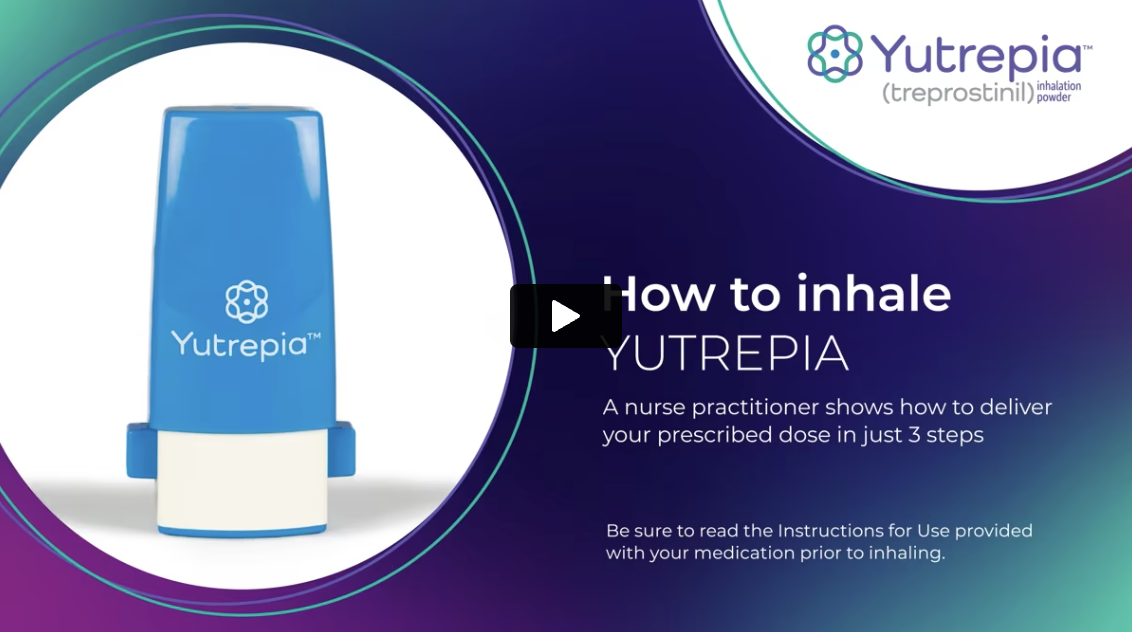
Get to Know Pulmonary Arterial Hypertension PAH
This is an educational resource to help you understand PAH

You may be eligible for a range of programs, including:
Your specialty pharmacy provider can work with you to determine which program may be right for you.
YUTREPIA is available through specialty pharmacy providers, who can guide you through every step of the process—from your first prescription to ongoing support. Your specialty pharmacy can:
Help with insurance and financial assistance options
Make sure your medicine is delivered
Answer your questions at any time
Provide in-home training on using YUTREPIA
No matter where you are in your journey, there are resources available to help.
Downloads


Get to Know Pulmonary Arterial Hypertension PAH
This is an educational resource to help you understand PAH
Video


How to Use YUTREPIA
An experienced nurse practitioner walks you through the steps to take YUTREPIA.
Before you take YUTREPIA, tell your healthcare provider about all of your medical conditions, including if you:
Tell your healthcare provider about all of the medicines you take, including prescription and over-the-counter medicines, vitamins, and herbal supplements. YUTREPIA and other medicines may affect each other.
Especially tell your healthcare provider if you take:
The most common side effects of YUTREPIA are cough, headache, throat irritation and pain, nausea, reddening of the face and neck (flushing), fainting or loss of consciousness, dizziness, diarrhea, and shortness of breath. Like other inhaled prostaglandins, you may have trouble breathing after taking YUTREPIA because it may cause the muscles around your airway to tighten (bronchospasm). These are not all the possible side effects. Call your doctor for medical advice about side effects or if you have trouble breathing.
You may report side effects to Liquidia at 1-888-393-LQDA (5732) or FDA at www.fda.gov/MedWatch or call 1-800-FDA-1088.
YUTREPIA is a prescription medicine used in adults to treat:
The risk information provided here is not comprehensive. To learn more about YUTREPIA, talk with your healthcare provider. Please see Full Prescribing Information for YUTREPIA and Instructions for Use. For additional information, call 1-888-393-5732.
Before you take YUTREPIA, tell your healthcare provider about all of your medical conditions, including if you:
Tell your healthcare provider about all of the medicines you take, including prescription and over-the-counter medicines, vitamins, and herbal supplements. YUTREPIA and other medicines may affect each other.
Especially tell your healthcare provider if you take:
What are the possible side effects of YUTREPIA?
This product can cause serious side effects, including:
The most common side effects of YUTREPIA are cough, headache, throat irritation and pain, nausea, reddening of the face and neck (flushing), fainting or loss of consciousness, dizziness, diarrhea, and shortness of breath. Like other inhaled prostaglandins, you may have trouble breathing after taking YUTREPIA because it may cause the muscles around your airway to tighten (bronchospasm). These are not all the possible side effects. Call your doctor for medical advice about side effects or if you have trouble breathing.
You may report side effects to Liquidia at 1-888-393-LQDA (5732) or FDA at www.fda.gov/MedWatch or call 1-800-FDA-1088.
The risk information provided here is not comprehensive. To learn more about YUTREPIA, talk with your healthcare provider. Please see Full Prescribing Information for YUTREPIA and Instructions for Use. For additional information, call 1-888-393-5732.